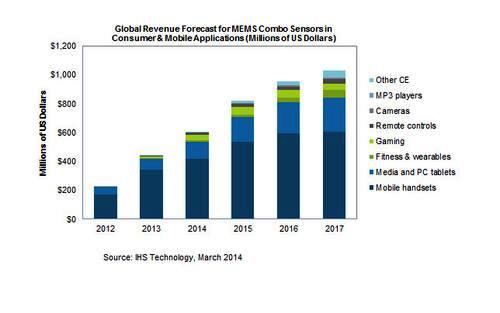Combination sensors have taken a prominent position at center stage in the MEMS, which stands for microelectromechanical systems, inertial sensor industry. This is due to the fact that electronic devices continue to develop and become increasingly intelligent, thus offering greater functionality to consumers in the form of applications. These come in the form of screen rotation, gesture recognition, gaming, step-counting, personal navigation and free fall detection.
In the past year, 6-axis inertial measurement units (IMUs), which is a combination of a 3-axis accelerometer and a 3-axis gyroscope packaged in a single chip, along with 9-axis IMUs, consisting of a single chip containing a 3-axis accelerometer, 3-axis gyroscope and 3-axis magnetometer, have gained significant popularity in the consumer electronics market.
This is reflected in the fact that in 2012 there was a 417 percent increase in the MEMS sensor market. This was followed by a 94 percent increase last year with an expected increase of another 37 percent for 2014. This information comes to us from analysis conducted by IHS Technology.
According to IHS’ report, global revenue for combo sensors in consumer and mobile applications will reach a projected $608.2 million this year. This represents a substantial increase from from last year’s $443.0 million. This is a clear indication of the market’s continued growth.
It is expected that by 2017, combo sensor revenue will not only hit, but also pass the billion dollar mark. The projection is that we can expect to see the figure at $1.03 billion. This can be seen in the graph below. It is equivalent to a four-year compound annual growth rate (CAGR) from 2013 of 23 percent.

Jeremie Bouchaud, who is the director and senior principal analyst for MEMS and sensors at HIS, said, “The main reason for the success of combo sensors is their convenience. They are expedient for original equipment manufacturers (OEM) who can buy just one device instead of two or three separate MEMS sensors. They also lend themselves to easy implementation as all combo sensors can be sold as plug-and-play solutions with their embedded sensor fusion algorithms, making for easier, more elegant deployment.”
With this statement in mind, it is no wonder that Samsung is at the top of the list of companies buying these combo sensors. Samsung spent $183 million, which is roughly 41 percent of the total combo sensor market in 2013. Its purchases included 6-axis IMUs from STMicroelectronics for the Galaxy S4 smartphone, from InvenSense for the Galaxy Note 3 smartphone and from Bosch for some Samsung’s Galaxy Tab tablets. So you can see that Samsung is also spreading the wealth around, so to speak.
In second place we have LG spending $47 million, representing an 11 percent share of the market. A close third is Sony with a $44 million payout for 6-axis combo sensors. Following the top 3 was a tight group of eight OEMs that collectively formed the next tier of purchasers. This group spent between $10 million to $16 million last year.
Not surprising, the three suppliers that Samsung spent $183 million on, STMicroelectronics, InvenSense and Bosch, collectively accounted for 99 percent of the MEMS combo sensor market last year.
Right now, smartphones and tablets represented 95 percent of the market for combo sensors. They will continue to take up the bulk of sales for the foreseeable future. IHS said, that 6-axis IMUs have largely taken the place of discrete gyroscopes in devices like smartphones and tablets for several OEMs.
The next logical progression is to see a lot more of the 6-axis and 9-axis combo sensors in wearable technology. We have already seen this in wearable devices that know if you are sitting, standing, laying down and whether you are in the correct position whiling in those stances.
Edited by
Cassandra Tucker  QUICK LINKS
QUICK LINKS